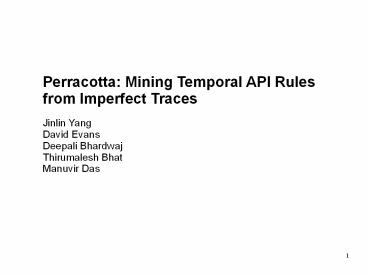Perracotta: Mining Temporal API Rules from Imperfect Traces - PowerPoint PPT Presentation
Title:
Perracotta: Mining Temporal API Rules from Imperfect Traces
Description:
Perracotta: Mining Temporal API Rules from Imperfect Traces Jinlin Yang David Evans Deepali Bhardwaj Thirumalesh Bhat Manuvir Das Agenda Background Perracotta ... – PowerPoint PPT presentation
Number of Views:79
Avg rating:3.0/5.0
Title: Perracotta: Mining Temporal API Rules from Imperfect Traces
1
Perracotta Mining Temporal API Rules from
Imperfect Traces Jinlin Yang David Evans Deepali
Bhardwaj Thirumalesh Bhat Manuvir Das
2
Agenda
- Background
- Perracotta
- Approximate Inference
- Contextual Properties
- Chaining
- Results
- Critique
3
Background
- Software tasks require specifications.
- What are the intended behaviors of the program?
- Expected outputs are necessary for testing.
- What aspects can be modified during maintenance
of software? - etc.
- The problem
- Many programs don't provide precise
specifications. - Many implementations are not consistent with
specifications. - As maintenance continues, specifications become
increasingly incorrect. - So?
- Several researchers have been motivated to study
the problem of specification inference.
4
Background (2)?
- Previous work
- Proposed an approach to dynamically infer
temporal properties of programs. - ...dynamically?
- To infer specifications by analysing sample
execution traces of a program. - ...temporal properties?
- ...deal with the order of occurrence of program
events. - ex) Property acquiring a lock should eventually
be followed by a release of the lock. - This paper addresses only inference of
Alternating Properties, because It's the
strictest of the template patterns and has proven
the most useful in practice. - ex) If A and B are events specified to behave
according to the Alternating Property, ABABAB,
not ABABBAAB.
5
Background (3)?
- Current limitations
- Inference algorithms scale poorly with the size
of the program and input trace. - Inferred properties only worked for perfect
traces. - ...in other words, there was an assumption that
the implementations of the traced programs were
correct. - Many of the inferred properties are
uninteresting since uninteresting properties add
up, this makes it unfeasible for large programs.
6
Background (4)?
- Quick summary of background
- Specifications tend to be inconsistent with
implementations. - Researchers have developed techniques to
dynamically infer specification properties of
programs. - ...however they suffer three notable limitations
- These techniques only work with small programs
- The techniques cannot detect specifications from
inconsistent implementations. - Many of the inferred properties are uninteresting
noise. - Contributions of this paper/Perracotta
- Address the above problems.
7
Perracotta
- Contributions
- Approximate Inference
- Makes it possible to infer a specification from
an implementation that is not always consistent
with that specification - Contextual Properties
- Allows for more precise inferences by keeping
track of contextual data instead of mere static
behaviors - Selection Heuristics
- Filters out the uninteresting properties, thus
greatly reducing the amount of noise from the
inferred properties.
8
Approximate Inference
- Imperfect traces
- It is expected that allocated memory will be
freed eventually, to avoid memory leak. - Unfortunately even skilled programmers fail to be
consistent with this temporal property,
especially in complex code. - A sample execution trace that is not consistent
with this property is an example of an imperfect
trace. - Previous algorithms failed to associate/infer
properties from imperfect traces, thus ruining
the whole point of dynamic inference. - Approximate Inference
- Infers a specification from an implementation,
even if the implementation is bugged with respect
to that specification
9
Approximate Inference (2)?
- STSTSTSTSTSSS
- Events (functions) S and T are called multiple
times in a trace. - They alternate n times, but there is no
alternation in last three S's. - Will Perracotta (successfully) infer the
Alternating Property from this? - Perracotta's approach
- Partition the trace
- S,TS,TS,TS,TS,TSSS
- Number of alternations 4
- Number of total partitions 5
- Satisfaction rate of Alternating Property 4/5
- The higher the satisfaction rate, the more likely
it is to infer. - The lower the predefined threshold value, the
more likely it is to infer.
10
Contextual Properties
- An acquired lock should eventually be released.
- But what if there are multiple locks?
- Context-neutral a lock was acquired
- Context-sensitive Lock1 was acquired
- Without context, the inference tool will treat
all locks as if they are the same lock, thus not
being able to infer anything about lock behavior.
11
Selection Heuristics
- Goal reduce the number of uninteresting
properties - ex) There is always a printf() before a
readLine() prompt. Infers nothing about API
specifications - uninteresting. - Reachability
- Events with call relationships are less
interesting than ones without.
12
Selection Heuristics (2)?
- Name Similarities
- Functions with similar names are likely to be
associated with interesting inferences. - ex) ExAcquireFastMutexUnsafe vs
ExReleaseFastMutexUnsafe - Chaining
- Suppose A-gtB, B-gtC, and A-gtC, that is, A and B
have Alternating Property, as to BC and AC. There
are three inferences. - It is correct to chain them into a single
inference ABC. - ...thus reducing the number of inferences from 3
to 1, reducing noise.
13
Results
- Test Programs
- Daisy
- JBoss
- Windows Kernel APIs
14
Results (2)?
15
Critique
- Likes
- The scope of the paper was narrowed down to the
Alternating Property. - It tackled problems worth solving in the field of
Dynamic Inference. - Actually detected a major bug in Windows.
- Dislikes
- Definitions of important keywords were all over
the place in the paper. - It's not very clear how they got the algorithm to
work with large programs. - The Approach section was actually merely the
approach for the previous work, not the current
one. There was no explicit label to clarify where
the overview of Perracotta starts.































